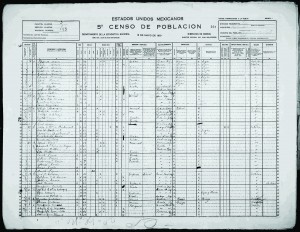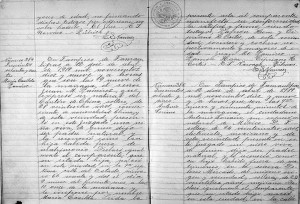
To distract myself from the horrible winter weather that has been thrown at Boston recently, I spent some time trying to research the family of my paternal grandfather, Richard Archibald Brown,[i] in sunny Mexico. This line has been a brick wall. And like many genealogists, I can’t help but try again and again, hoping that this will be the time I finally break through.
Rather than just jumping in head first like I had done in the past, I figured it was time to learn the basics of Mexican genealogical research. My first stop was the FamilySearch Research Wiki, which offers guides to family history and research for just about every county in the world. One of the guides that I found the most helpful was the Spanish Genealogical Word List, which is just as it sounds: English translations of numbers, census categories, diseases, occupations, and other words that you may encounter when doing research in a foreign language.
After my crash course on genealogical research in Mexico, I started with the 1930 Mexico National Census and found my ancestors living in Pachuca de Soto, Hidalgo. I did learn a few things I never knew before; for example, I did not know my great-grandfather Frederick Brown was an accountant, or that the entire family, with the exception of Frederick, was Catholic. But I was frustrated that the birthplaces of my grandfather, his siblings, and my great-grandmother were listed simply as “Mexico,” when everyone else had a more specific birthplace. I suddenly remembered that my father had once mentioned that my grandfather had been born in a place called Tampico. Thus I decided to look at the civil registrations for that city, which are available online at FamilySearch.org.

After searching through the registry and not finding my grandfather, I became frustrated and had to take a few laps around the room before I could sit down and continue. Only then did I remember what a co-worker had suggested: since my grandfather was born to a British father and held British citizenship, his birth could have been registered with the British Consulate in Mexico. Wishing I’d remembered that hours earlier, I went online and easily ordered a copy of my grandfather’s birth certificate from the British General Register Office.
I’m going to put the research on this part of my family on hold until I receive the birth certificate. I’m hoping it will hold pieces of information that may open up new doors to research on this part of my family. Nonetheless, I’m very happy I’ve learned some basics of Mexican research and have seen what a goldmine the civil registrations can be. The listings of birth in Tampico are incredibly detailed, including not only the usual information about the birthplace of the child and the names of the child’s parents, but also the names of both the maternal and paternal grandparents. As an added bonus, the handwriting—in the Tampico records, at least—was incredibly neat and legible. Although it would have been nice to have had my grandfather’s ancestry served to me on a silver platter, I do believe that there is something to be said about the thrill of the hunt. I often find myself giddily racing home to check the mail to see if my grandfather’s birth certificate has arrived, hoping that it may be the key to unlocking this particular research challenge.
Notes
[i]
See “Like father, like son—like daughter?” Vita Brevis, August 15, 2014.
I’ve done some research using Mexican records as well and found that most handwriting is quite legible and with a very basic knowledge of Spanish can be fairly easily deciphered.
Where did you go online for the Consulate records? I have a similar situation, an Elizabeth (or Isabel in Spanish) MacIntosh, who was born possibly in Guadalupe, Mexico, supposedly daughter of a diplomat of some sort. She only spoke Spanish until moving to Colorado as an adult, so everyone thought she was Hispanic, not full-blooded Scot. That’s all the information I got from my ex-mum-in-law, and have only been able to find her border-crossing record from 1919. Your source sounds promising….
I am caught in the same way with my father side of the family. I am unable to find nothing on my living father, age 83 San Antonio, TX. The family my father is claiming to belong too, census records, never list him with that family. All eight other siblings are listed on census records with the parents he states are his parents too; all born in Texas. What happens when one child is never listed with the rest of the family and why? When my father retired from his employer he needed proof of US Citizen and was not able to obtain it because he is listed under different parents. So, he became US naturalization citizen. So, I am at a dead end because he added this family as parents. I need to find the real parents and not what I think are his guardian family. I have looked into records of Mexico and Spain because of the Spanish Surname; no luck. I have looked under the family he gave me and nothing. So, we took Ancestry DNA to determine blood line and he came with 65% Native American! Gee, now what? I have been doing genealogy research for over fifteen years and have no problems with finding other family members. But I am at a dead end with my father side. Any more tips any of you can guide me through, I greatly appreciate it.